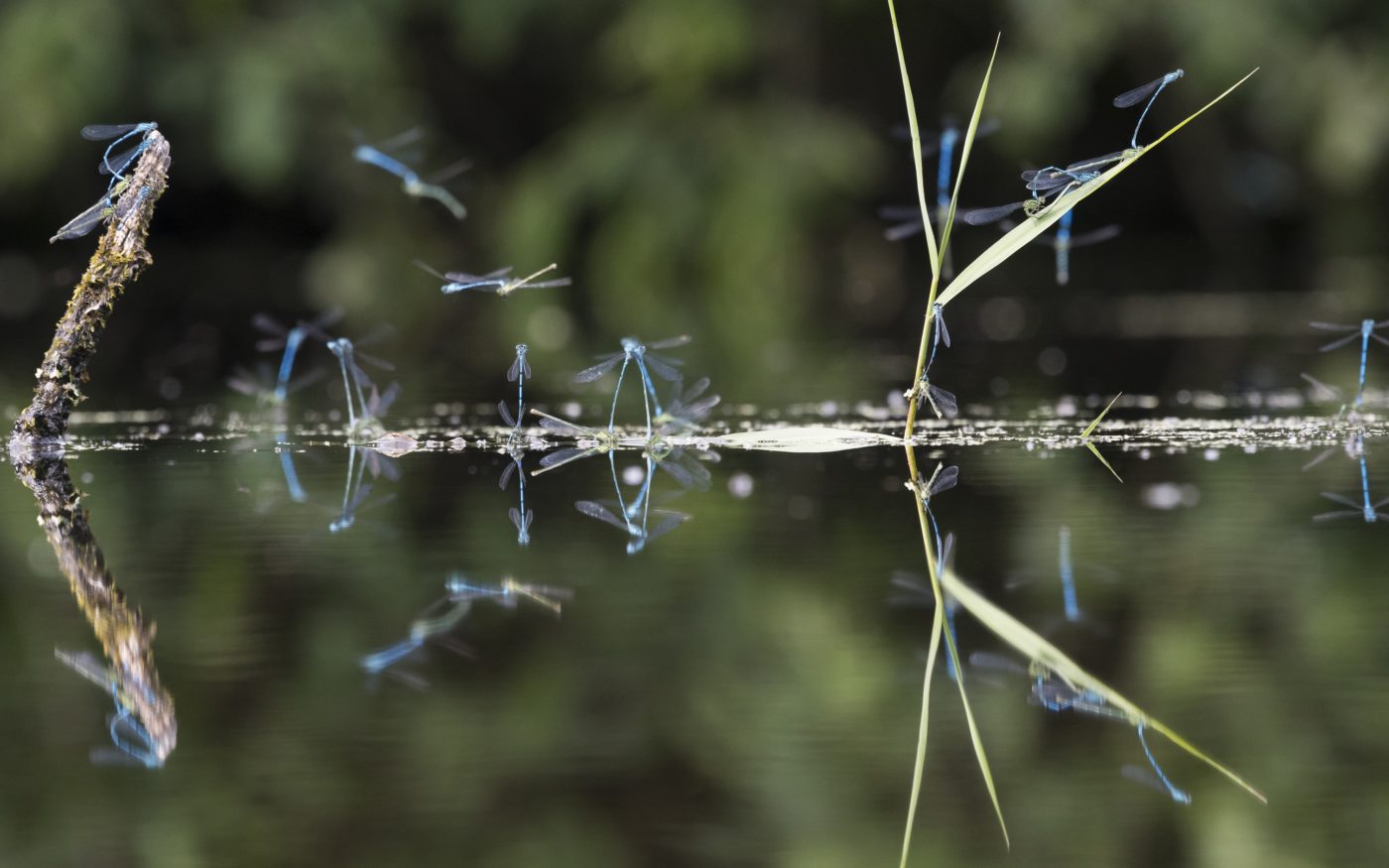What is a biological record?
Four pieces of information about an insect that you find:
- WHAT the name of the species of insect.
- WHO the name of the person who found the insect.
- WHERE the location the insect was found ine.g. Ordnance Survey grid reference, postcode or nearest named location.
- WHEN the calendar date the insect was found
Other information could include the habitat, food plant, time of day, weather, life stage of the insect, trapping or survey method. A photograph or video may be taken of the insect and in some cases a voucher specimen.
Why do we make biological records of insect species?
Biological records build a picture of where an insect species occurs (distribution), when it occurs in the year (phenology) and the habitat the insect is associated with (ecology).
To monitor insect species, and see whether they are increasing or decreasing, we need detailed biological records to be collated over time. Your records can help ‘measure the health’ of insects in the UK.
How do we submit biological records to a recording scheme?
The best way in the UK is to use the smartphone application iRecord which is available for android on Google Play and for apple in the App Store.

You can use iRecord on your phone in your garden or at home when you see an insect. Your phone camera can take an image and upload it to the app, so even if you are not sure what the insect is, someone else can hopefully work out ‘What’ the insect is. You will create an account with iRecord which will provide the ‘Who’ information. The GPS on the smartphone can provide the ‘Where’ information and lastly you can enter the ‘When’ information, which can also come from image file data.
You can also submit records on the iRecord website with an internet browser.
Data from iRecord is communicated to expert recorders around the UK, who will verify and compile data on a particular group of insects.
Insect recording schemes
You can find out more about recording schemes and experts for particular groups of insects (and a few non insects) from the following list, this is from the Biological Record Centre and the National Biodiversity Network. Your Local Environment Record Centre may have details of local recording schemes in your area. If you are in the Republic of Ireland please look at the National Biodiversity Data Centre for information on biological recording.
| taxonomic order | common name(s) | recording scheme URL |
|
Coleoptera |
aquatic beetles | |
|
Coleoptera |
Soldier beetles, jewel beetles & glow-worms |
www.brc.ac.uk/scheme/soldier-beetles-and-allies-recording-scheme |
|
Coleoptera |
Ground beetles | |
|
Coleoptera |
Longhorn beetles | |
|
Coleoptera |
Seed and leaf beetles | |
|
Coleoptera |
Lily beetle | |
|
Coleoptera |
Rosemary beetle | |
|
Coleoptera |
Ladybird beetles | |
|
Coleoptera |
Weevils & bark beetles | |
|
Coleoptera |
Hide, larder & carpet beetles | |
|
Coleoptera |
Click beetles & allies | |
|
Coleoptera |
Clown beetles | |
|
Coleoptera |
Dung beetles | |
|
Coleoptera |
Marsh beetles | |
|
Coleoptera |
Carrion, burying, sexton beetles & relatives | |
|
Coleoptera |
Rove beetles | |
|
Coleoptera |
Stenini rove beetles | |
|
Coleoptera |
Darkling beetles | |
|
Coleoptera |
Oil beetles | |
|
Coleoptera |
Stag beetles |
https://ptes.org/get-involved/surveys/garden/great-stag-hunt/stag-hunt-survey/ |
|
|
|
|
|
Diptera |
Leaf-mining flies | |
|
Diptera |
Root maggot flies | |
|
Diptera |
Blowflies | |
|
Diptera |
Non-biting midges | |
|
Diptera |
Frit flies | |
|
Diptera |
thick-headed flies, spear-winged flies & picture-winged flies | |
|
Diptera |
Mosquitoes | |
|
Diptera |
Meniscus midges & trickle midges | |
|
Diptera |
Dagger flies, dance flies & long-legged flies | |
|
Diptera |
Spiny-winged flies | |
|
Diptera |
Fungus gnats | |
|
Diptera |
Stilt & stalk flies | |
|
Diptera |
Warble-flies & bots | |
|
Diptera |
Big-headed flies | |
|
Diptera |
Flat-footed Flies | |
|
Diptera |
Dung-flies and relatives | |
|
Diptera |
Snail-killing flies |
https://www.dipterists.org.uk/snail-killing-flies-scheme/home |
|
Diptera |
Ensign flies | |
|
Diptera |
Soldierflies & Allies |
https://www.dipterists.org.uk/soldierflies-allies-scheme/home |
|
Diptera |
Hoverflies | |
|
Diptera |
Parasitic flies | |
|
Diptera |
Fruit flies | |
|
Diptera |
Craneflies | |
|
Diptera |
Hemerocallis gall midge |
https://www.rhs.org.uk/science/help-our-research/hemerocallis-gall-midge |
| Diptera | Flesh flies | https://dipterists.org.uk/sarcophagidae-scheme/home |
Diptera | Woodlouse flies | https://dipterists.org.uk/rhinophoridae-scheme/home |
Diptera | Lance flies | https://dipterists.org.uk/lonchaeid-group/home |
Diptera | Lesser dung flies | https://dipterists.org.uk/sphaeroceridae-group/home |
Diptera | Kelp flies | https://dipterists.org.uk/kelp-fly-scheme/home |
Diptera | Keds, flat-flies or louse-flies, and bat-flies | https://dipterists.org.uk/hippoboscidae-scheme/home |
|
Ephemeroptera |
Mayflies | |
|
|
|
|
|
Hemiptera |
Leafhoppers & froghoppers | |
|
Hemiptera |
Water bugs | |
|
Hemiptera |
Shield bugs & allies | |
|
Hemiptera |
Plant bugs & allies | |
|
Hemiptera |
plant lice | |
|
|
|
|
|
Hymenoptera |
Bees, wasps & ants | |
|
Hymenoptera |
Parasitic wasps |
https://www.brc.ac.uk/scheme/parasitic-wasps-recording-scheme |
|
Hymenoptera |
Sawflies | |
|
Hymenoptera |
Berberis sawfly |
https://www.rhs.org.uk/science/help-our-research/berberis-sawfly |
|
Hymenoptera |
Asian Hornet Vespa velutina |
https://www.nonnativespecies.org/non-native-species/species-alerts/#Species_53 |
Hymenoptera | Bees, wasps & ants | https://www.bumblebeeconservation.org/beewalk/ |
|
|
|
|
|
Lepidoptera |
Butterflies | |
|
Lepidoptera |
Moths | |
|
Lepidoptera |
Grass moths |
https://www.brc.ac.uk/scheme/crambidae-pyralidae-recording-scheme |
|
Lepidoptera |
Twirler moths | |
|
Lepidoptera |
Longhorn moths & allies |
https://www.brc.ac.uk/scheme/incurvarioidea-recording-scheme |
|
Lepidoptera |
Leaf-mining moths | |
|
Lepidoptera |
Plume moths | |
|
|
|
|
|
Neuroptera |
Lacewings, scorpion-flies, snake-flies & allies | |
|
|
|
|
|
Odonata |
Dragonflies & damselflies | |
|
|
|
|
|
Orthoptera |
Grasshoppers, crickets, earwigs, cockroaches, stick-insects & mantids | |
|
|
|
|
|
Plecoptera |
Stoneflies | |
|
|
|
|
|
Psocoptera |
Barkflies | |
|
|
|
|
|
Siphonaptera |
Fleas |
https://www.brc.ac.uk/scheme/siphonaptera-and-phthiraptera-recording-scheme |
|
|
|
|
|
Trichoptera |
Caddisflies | |
|
|
|
|
| Plant galls | Many different organisms | British plant Gall Society https://www.britishplantgallsociety.org/ |
| NON INSECTS |
|
|
|
Collembola |
Springtails | |
|
Arachnida |
Spiders & Harvestmen | |
|
Arachnida |
Mites | |
|
Arachnida |
Ticks | |
|
Arachnida |
Pseudoscorpions | |
|
Myriapoda |
Centipedes, millipedes, pauropods & symphylans | |
|
Isopoda |
Woodlice & waterlice | |
|
Mollusca |
Snails and slugs | |
|
Annelida |
Earthworms |

